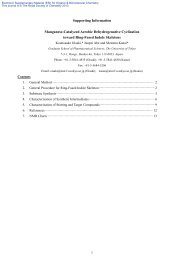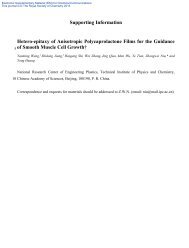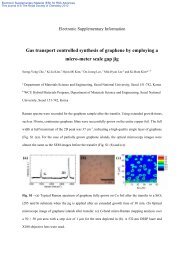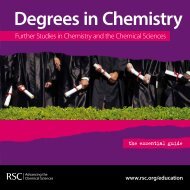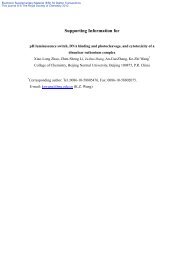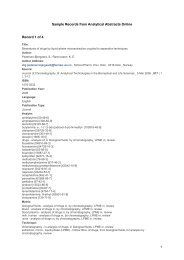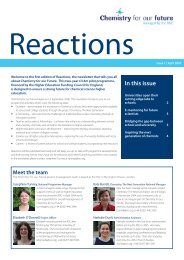Representation of Ethnic Groups in Chemistry and Physics
Representation of Ethnic Groups in Chemistry and Physics
Representation of Ethnic Groups in Chemistry and Physics
You also want an ePaper? Increase the reach of your titles
YUMPU automatically turns print PDFs into web optimized ePapers that Google loves.
6: <strong>Ethnic</strong>ity <strong>and</strong> science at A-level<br />
30<br />
percentage <strong>of</strong> all females aged 18/19<br />
20<br />
10<br />
0<br />
30<br />
white black Caribbean black African Indian Pakistani Bangladeshi Ch<strong>in</strong>ese<br />
any science A-level, <strong>in</strong>clud<strong>in</strong>g mathematics<br />
mixed<br />
percentage <strong>of</strong> all females aged 18/19<br />
20<br />
10<br />
1 science<br />
2 sciences<br />
3 sciences<br />
4 or more sciences<br />
0<br />
white black Caribbean black African Indian Pakistani Bangladeshi Ch<strong>in</strong>ese<br />
number <strong>of</strong> sciences, <strong>in</strong>clud<strong>in</strong>g mathematics<br />
mixed<br />
Fig. 8: A-level sciences<br />
for females, by ethnic<br />
group.<br />
Source: Youth Cohort Study,<br />
1996–2002<br />
23. Note that the st<strong>and</strong>ard errors<br />
on the proportions reported from<br />
the YCS are quite large <strong>in</strong> some<br />
cases, <strong>and</strong> <strong>in</strong> particular among<br />
ethnic-m<strong>in</strong>ority groups whose<br />
sample numbers <strong>in</strong> the survey are<br />
quite small. In contrast, st<strong>and</strong>ard<br />
errors for the majority white<br />
population are small, giv<strong>in</strong>g us a<br />
high degree <strong>of</strong> confidence with<br />
regard to our f<strong>in</strong>d<strong>in</strong>gs for this<br />
group.<br />
differences by ethnic group are along the l<strong>in</strong>es <strong>of</strong> those discussed<br />
so far, with differences by ethnic group generally<br />
more pronounced among males.<br />
Trends with time <strong>in</strong> atta<strong>in</strong>ment <strong>of</strong> chemistry <strong>and</strong> physics<br />
A-levels by YCS cohort are reported <strong>in</strong> appendix 4. Sample<br />
sizes for ethnic-m<strong>in</strong>ority groups are very small <strong>in</strong> a s<strong>in</strong>gle<br />
cohort, so non-white groups are comb<strong>in</strong>ed <strong>and</strong> compared<br />
with the white population.<br />
6.2: Potential undergraduate scientists<br />
Consideration <strong>of</strong> the next stage along the educational<br />
pipel<strong>in</strong>e requires identification <strong>of</strong> the proportion <strong>of</strong> young<br />
people, by ethnic group, who might be considered “potential<br />
undergraduate scientists” (i.e. either potential undergraduate<br />
chemists or physicists), based on subject choices<br />
<strong>and</strong> achievement at A-level.<br />
This concept is useful <strong>in</strong> provid<strong>in</strong>g an ethnic pr<strong>of</strong>ile <strong>of</strong><br />
the pool <strong>of</strong> students from which chemistry <strong>and</strong> physics is<br />
recruit<strong>in</strong>g at higher levels.<br />
The detailed concept <strong>of</strong> the potential undergraduate<br />
chemist or physicist is outl<strong>in</strong>ed <strong>in</strong> section 2, <strong>in</strong>clud<strong>in</strong>g prerequisite<br />
subject choices <strong>and</strong> grades obta<strong>in</strong>ed at A-level.<br />
The section gave three def<strong>in</strong>itions accord<strong>in</strong>g to different<br />
levels <strong>of</strong> achievement <strong>in</strong> A-level studies, based on the number<br />
<strong>of</strong> UCAS po<strong>in</strong>ts achieved. In short, a potential undergraduate<br />
chemist is def<strong>in</strong>ed as achiev<strong>in</strong>g an A-level <strong>in</strong><br />
chemistry, plus 12, 18 or 24 UCAS po<strong>in</strong>ts (with a m<strong>in</strong>imum<br />
<strong>of</strong> a grade C <strong>in</strong> chemistry, or grade B for 24 UCAS po<strong>in</strong>ts);<br />
the potential undergraduate physicist is expected to<br />
achieve an A-level <strong>in</strong> physics <strong>and</strong> <strong>in</strong> a mathematics-related<br />
discipl<strong>in</strong>e plus 12, 18 or 24 UCAS po<strong>in</strong>ts (with a m<strong>in</strong>imum<br />
<strong>of</strong> a grade C <strong>in</strong> physics, or grade B for 24 UCAS po<strong>in</strong>ts).<br />
Apply<strong>in</strong>g these def<strong>in</strong>itions to the pooled YCS data for<br />
1996–2002 provides estimates <strong>of</strong> the proportions <strong>of</strong><br />
potential undergraduate chemists/physicists. Figure 10<br />
presents the proportions <strong>of</strong> the population aged 18/19 by<br />
ethnic group <strong>and</strong> gender who may be categorised as potential<br />
undergraduate chemists. The detailed figures, <strong>in</strong>clud<strong>in</strong>g<br />
st<strong>and</strong>ard errors <strong>and</strong> sample sizes, are presented <strong>in</strong><br />
appendix 3. Similarly, figure 11 shows the proportions <strong>of</strong><br />
the population aged 18/19 years by ethnic group <strong>and</strong> gender<br />
who may be categorised as potential undergraduate<br />
physicists. The detailed figures, <strong>in</strong>clud<strong>in</strong>g st<strong>and</strong>ard errors<br />
<strong>and</strong> sample sizes, are presented <strong>in</strong> appendix 4. 23<br />
16 R EPRESENTATION OF E THNIC G ROUPS IN C HEMISTRY AND P HYSICS M AY 2006





